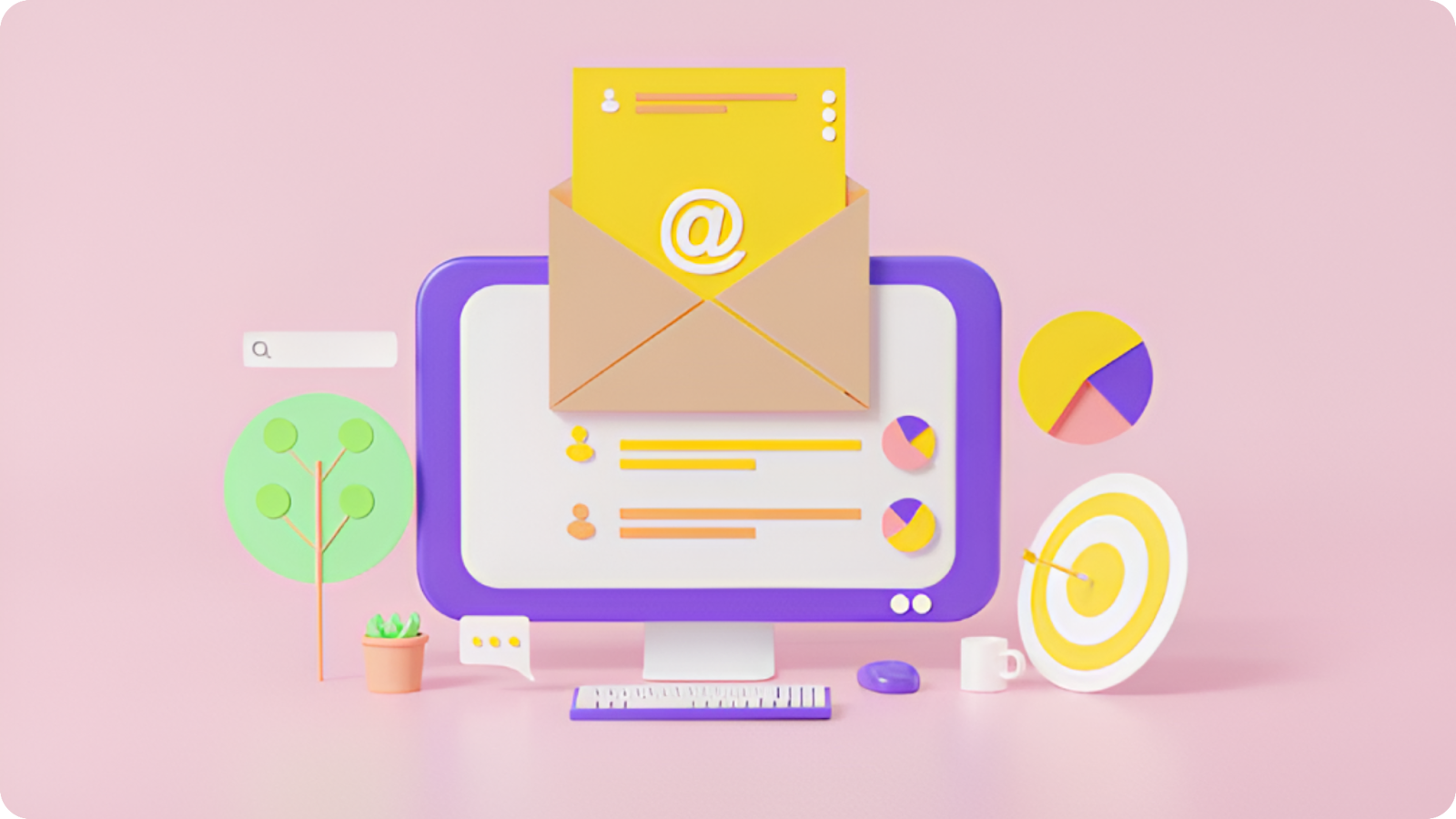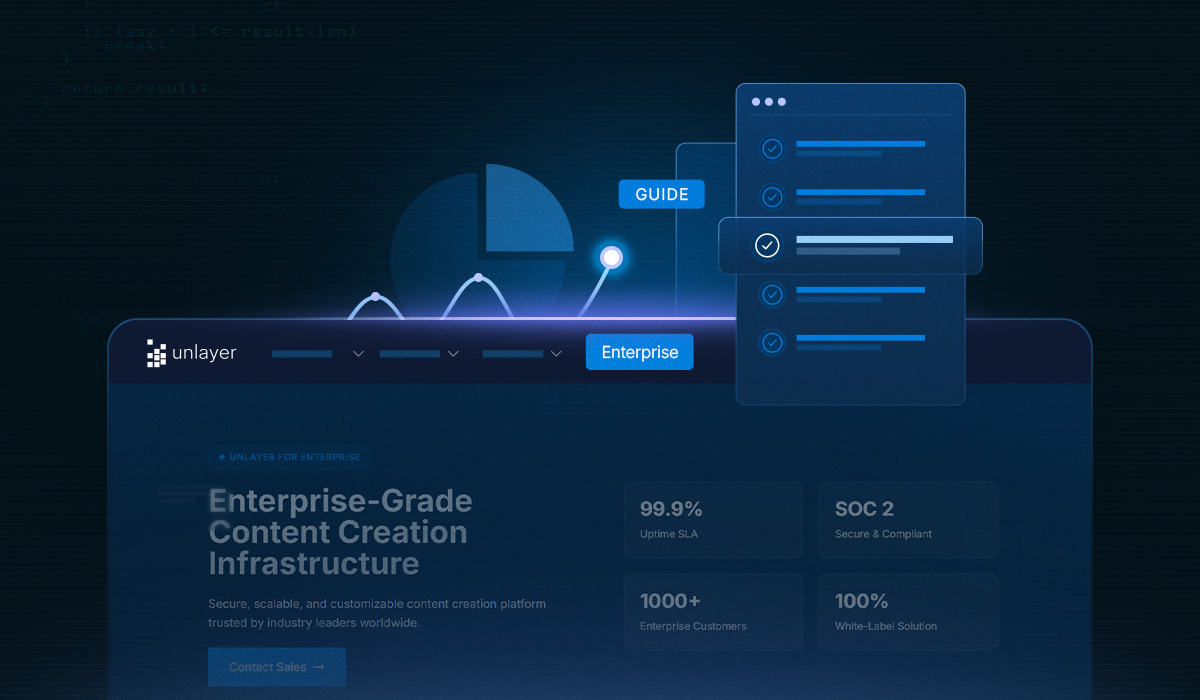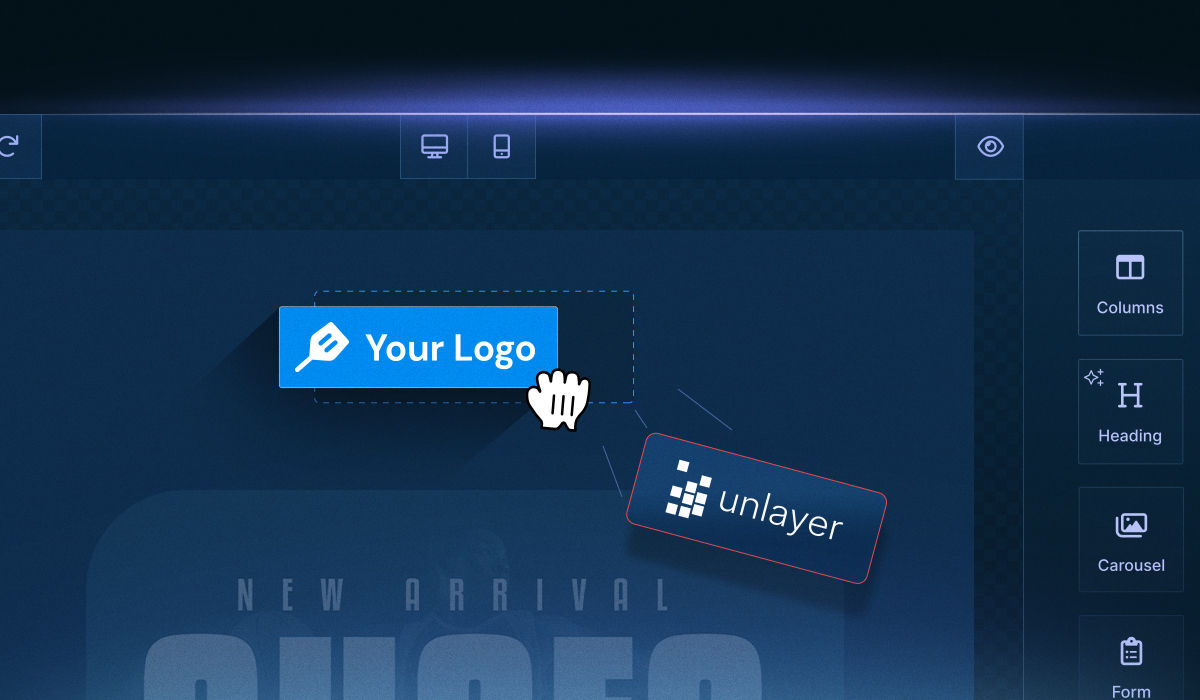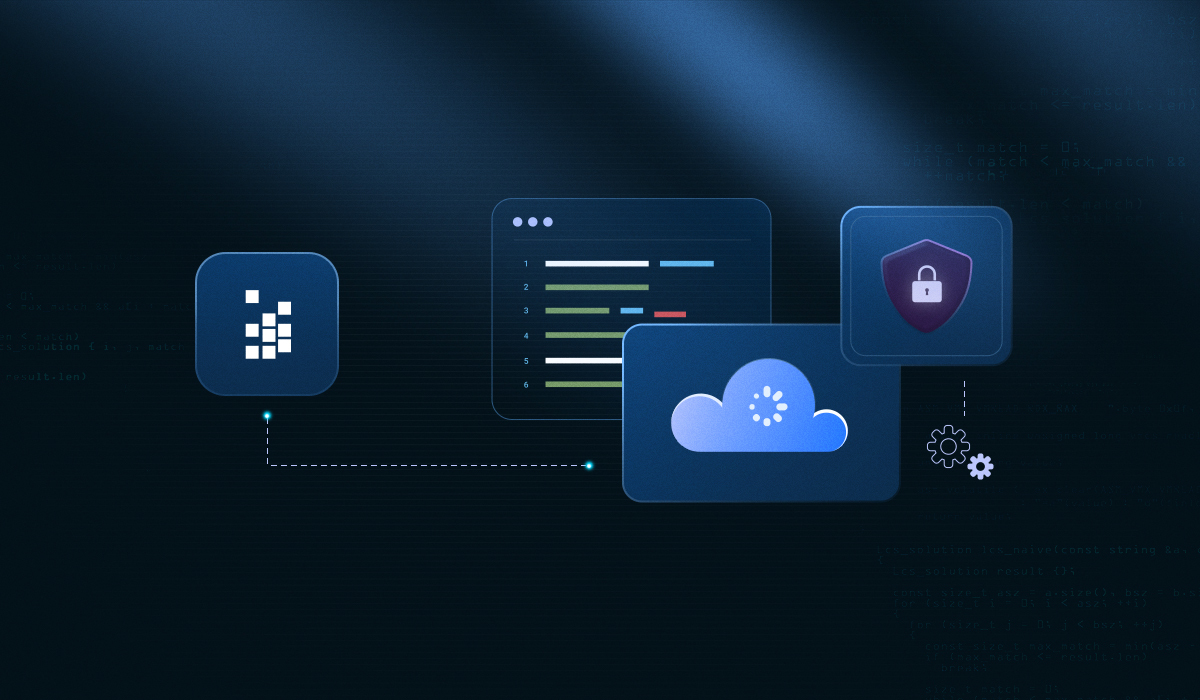SaaS platforms no longer need to build email editors from scratch. Embeddable email builders now let teams integrate full editing capabilities directly into their products without rebuilding core features. So, which email builder benchmarks define a best-in-class editor in 2025?
Key Takeaways
Embedded email builders are now standard across SaaS platforms
AI support is expected, with features like copy generation and layout suggestions
No-code, mobile-first, and personalized editing are core expectations
Implementation success depends on governance, workflows, and clean output
Unlayer matches the benchmark standards set for embedded builders in 2025: white-labeled, API-first, and automation-ready
What Is an Email Builder?
An email builder is a visual editor that allows users to create, edit, and structure email content without writing code. Most modern builders use a drag-and-drop interface, enabling users to add blocks for text, images, buttons, or dynamic elements while maintaining a responsive design.
Unlike standalone design tools, email builders are now embedded components that sit inside your core business stack, whether that’s a CRM, marketing automation platform, client portal, or internal system.
Role of Email Builders in SaaS Platforms
SaaS platforms are shifting from full-stack development to modular assembly. Gartner calls this the move toward application composition, where tools are integrated, not built, by the teams using them.
As VP of Gartner, Milind Govekar puts it, “The technological and organizational silos of application development, automation, integration, and governance will become obsolete.”
While Email remains the backbone of SaaS communication, designing emails from scratch is slow and expensive. McKinsey reports that custom software efforts overrun by 66% on budget and 33% on timeline while delivering 17% less value.
So, here’s what to watch out for: 7 Hidden Costs of Building an In-House Email & Page Builder
That’s why SaaS teams are embedding email builders instead. Purchasing a customizable builder saves engineering time, reduces cost, and puts design control into users' hands.
And as both SaaS and email marketing evolve, the builder itself is changing, too.
Email Builder Benchmarks: 8 Key Standards for 2025
SaaS platforms are being rebuilt around speed, simplicity, and user control. Businesses now expect software to be usable by anyone, not just engineers, whether it’s for designing workflows, sending campaigns, or building interfaces.
This shift is pushing tools like email builders to evolve from basic editors into full-featured components that support real-time personalization, automation, and compliance. These capabilities are now shaping the email builder benchmarks inside modern SaaS platforms.
The following trends show how email builders are adapting to these new demands in 2025.

1. Artificial intelligence
We are now in the AI age, where generative tools are reshaping how businesses create, automate, and scale their operations.
The momentum is real: 92% of companies plan to increase their investment in generative AI over the next three years.
Inside email builders, this shift is already underway. AI is moving from a backend feature to something users interact with directly. These capabilities define the new standard for email builder benchmarks inside SaaS platforms, where AI support is expected, not experimental.
Modern builders now come with AI configuration, offering:
AI text generators trained on brand tone
Predictive recommendations for headers or CTAs
Image suggestions and layout tweaks based on audience behavior
This completely changes the role of the email builder. It’s no longer just a drag-and-drop interface. It’s becoming an active writing assistant, campaign optimizer, and personalization engine rolled into one. For SaaS teams, this means faster workflows, fewer bottlenecks, and more effective communication at scale.
2. No-code and low-code editors
Low-code and no-code tools are designed to help users build software, workflows, or digital content without writing code. Instead of relying on developers, teams use visual interfaces to assemble what they need faster and with less friction.
This shift has led to the rise of LCAPs (Low-Code Application Platforms), where teams across departments can build tools and content independently.
Gartner predicts that by 2026, developers outside formal IT departments will account for at least 80% of the user base for low-code development tools.
👉 Wondering which no-code tools are actually worth your time? Here are 5 customizable builders developers love.
What this looks like inside SaaS platforms:
Drag-and-drop blocks for text, buttons, columns, images, and dynamic sections
Reusable templates for onboarding, marketing, and product updates
Centralized styling for brand consistency across all emails
Admin controls to manage who can edit, publish, or reuse layouts.
3. White labeling
Most SaaS users now expect every part of the interface, including the email editor, to feel like a seamless extension of the product. Branding inconsistencies break trust, especially when users move between dashboards, forms, and communication tools. That’s why whitelabeling has become a standard benchmark in embedded email builders.
White labeling lets platforms embed third-party tools while removing external branding. From typography to layout behavior, every element can be styled to match the host product, without the overhead of building from scratch.
What modern white-labeled builders support:
Full control over UI components, including colors, fonts, and button styles
Custom block styling to match product-specific layouts
Ability to hide vendor branding entirely from the user experience
Flexible embedding to match app navigation, structure, and permissions
These capabilities allow SaaS teams to ship a polished, on-brand editor in days, not months, while retaining full control over the user interface and editing workflow.
4. Personalization
Today’s users don’t judge software by features; they judge it by experience. According to Salesforce, 80% of customers say a company's experience is as important as its products and services.
Email remains one of the most direct channels that shapes that experience, and personalization is what makes it work. A survey found that 59% of the top email marketers consider personalization one of the most effective ways to boost email engagement.
Editors now include features that let teams create one-to-one experiences at scale, without needing external tools or custom code.
What modern email editors offer:
Insert variables for name, plan, company, or usage stats
Use display conditions to show or hide content blocks based on segments.
Trigger dynamic sections based on user behavior
Preview designs in real time for different user profiles
These capabilities let SaaS teams tailor onboarding emails by role, highlight upgrades based on feature use, or show relevant case studies by industry, all from within the editor.
5. Mobile-first design
Email engagement has gone mobile. With 41% of email views coming from mobile devices, optimizing for smaller screens is no longer optional. And poor design has consequences: 52% of customers say they’re less likely to engage with a brand if their emails display poorly on mobile.
This shift has pushed email builders to prioritize mobile optimization by default. It’s no longer enough to create a desktop-first layout and hope it scales down. Editors must give users the tools to design specifically for smaller screens.
How modern email builders are adapting:
Live mobile previews as a default view, not a toggle
Stackable content blocks that adjust automatically
Mobile-specific padding, font sizing, and CTA placement options
Block-level visibility settings (e.g., show on mobile, hide on desktop)
For SaaS platforms embedding email editors, mobile-first design isn’t just a UX improvement. It’s a core part of modern email builder benchmarks. It ensures that every campaign, onboarding flow, or alert is readable, tappable, and conversion-ready on the devices users rely on most.
6. Automation
Email in SaaS is handled through automated systems. Onboarding prompts, usage alerts, and re-engagement campaigns are typically triggered by user behavior or lifecycle events. These flows require consistent templates and structured content, not one-off designs.
How modern email builders support automation workflows:
Templates that can be saved, cloned, and deployed across multiple triggers
Blocks that update based on user attributes or event logic
Tagging systems for sorting assets inside campaigns or CRMs
Clean, structured HTML that works inside email automation platforms
Automation goes beyond marketing. Product updates, system alerts, and account notices often run on the same template engine. That’s why embedded editors must deliver reliable, reusable outputs that support broader SaaS workflows. Many teams now use these builder capabilities to define internal benchmarks for email quality and automation readiness.
7. Security
Security is a core part of the email builder benchmarks for 2025, particularly when email content includes user data, system alerts, or account-related messaging, as it transitions into SaaS platforms. Teams expect the same standards from their email editor as they do from their infrastructure: compliance, access control, and data protection.
This expectation is driving changes in how email builders are built and selected.
What SaaS platforms look for in secure editors:
SOC 2 Type II certification and GDPR compliance
On-premise deployment options for regulated industries
Role-based access control and user permissions
Audit logs for content changes and publishing activity
Secure storage and rendering of templates with dynamic data.
8. Integration capabilities
APIs are now a core part of how SaaS platforms connect with other tools, manage data, and support scale. As more teams adopt specialized SaaS solutions, the need to integrate them into existing systems keeps growing.
Early on, many SaaS vendors didn’t offer full integration paths. This slowed adoption, especially for businesses trying to connect new tools to their CRMs, automation platforms, or internal workflows. Today, that’s changed. APIs are treated as product features, not backend support layers. A builder that doesn’t integrate cleanly can’t fit into the stack.
How does this apply to email builders?
REST APIs to sync templates, users, assets, and metadata
Webhooks to trigger actions or pull dynamic content in real-time
Support for authentication, user roles, and folder structures via API
Compatibility with external systems like CRMs, CDPs, or analytics tools
Before email builders can deliver on all the potential outlined above, they need to be implemented correctly, governed consistently, and secured properly. While the benchmarks are strong, the path to adoption still comes with practical hurdles and a few clear opportunities for SaaS teams to do more with less.
4 Implementation Challenges When Embedding an Email Builder

The trends above show where the email builder space is headed. But adoption comes with its own set of internal challenges, from compliance to workflow design. Here's what product teams need to account for when embedding a builder at scale.
1. Governance requires structure from day one
Email builders often serve multiple teams: marketing, product, and customer success. Without clear ownership and structure, issues like template duplication, styling drift, and inconsistent approvals quickly emerge.
Look for builders that support block libraries, user permissions, and folder-level organization to help prevent this early.
2. Security and compliance must be at the editor level
Editors work with content tied to user data in regulated industries, which raises the bar for access control and auditability.
The builder must meet the same compliance standards as the platform, including SOC 2, GDPR, audit logs, and authentication via API.
3. The setup can break down without workflow planning
Teams often integrate editors quickly, then struggle to scale. Without planning for team onboarding, content review, and brand governance, templates become inconsistent and hard to maintain.
What to look for: Builder features that support user training, approval flows, asset grouping, and styling systems that align with your design guidelines.
4. Inconsistent output impacts UX and reliability
Even when the editor is easy to use, poor output can degrade the user experience. Cluttered HTML or missing responsiveness harms trust and engagement.
Choose a builder that generates clean code, renders reliably across clients, and allows testing before release.
Build Faster With Unlayer’s Embeddable Email Editor
Unlayer gives SaaS teams a powerful, developer-ready email builder that fits directly into your platform. Key features include:
Drag-and-drop editor with mobile-first, responsive blocks
Real-time collaboration with version history and comment threads
Full UI customization to match your brand and workflows
Role-based access controls and user permissions
SOC 2 Type II compliance and GDPR-ready infrastructure
API-first architecture with SDKs for React, Vue, and Angular
Custom block development and asset library support
Clean, production-ready HTML output for automation flows
The email layer is now central to product communication. Staying ahead means embedding tools that meet the 2025 email builder benchmarks for creation, flexibility, speed, security, and automation readiness.
Wanna see Unlayer in action? Sign Up!
FAQs About Email Builder Benchmarks
Got questions? Let’s address some common questions about embedded email builders.
1. What makes an embedded email builder better than external tools?
Embedded builders reduce workflow friction by keeping users inside the platform. They also simplify compliance, styling, and data control, key factors in the 2025 email builder benchmarks. Unlike external tools, embedded email builders give SaaS teams deeper integration and ownership over the editing experience.
2. How do embedded email builders make life easier for developers?
Using an embedded email builder reduces the need for frontend development, template maintenance, and update cycles. Builders that meet today’s benchmark provide SDKs, API endpoints, and clean HTML output, so devs can focus on integration logic instead of reinventing an editor from scratch.
3. Can embedded email builders support non-marketing use cases?
Yes. A scalable email builder supports transactional messages, usage alerts, support replies, and internal notifications. These use cases are part of the broader 2025 email builder benchmarks, where editors must serve multiple teams, not just marketing.
4. How do platforms customize embedded builders to match their product?
Custom UI, block styling, and role-based behavior are now standard.
Platforms that meet the email builder benchmarks offer whitelabeling, custom block support, and config-level design controls, so the editor looks and behaves like a native part of your app.
5. What’s the difference between a good editor and a benchmark editor?
A good editor offers ease of use. A benchmark-level editor delivers scalable systems: reusable templates, permission controls, API deployment, and reliable output across clients. This distinction is key when embedding editors into high-growth SaaS products.





